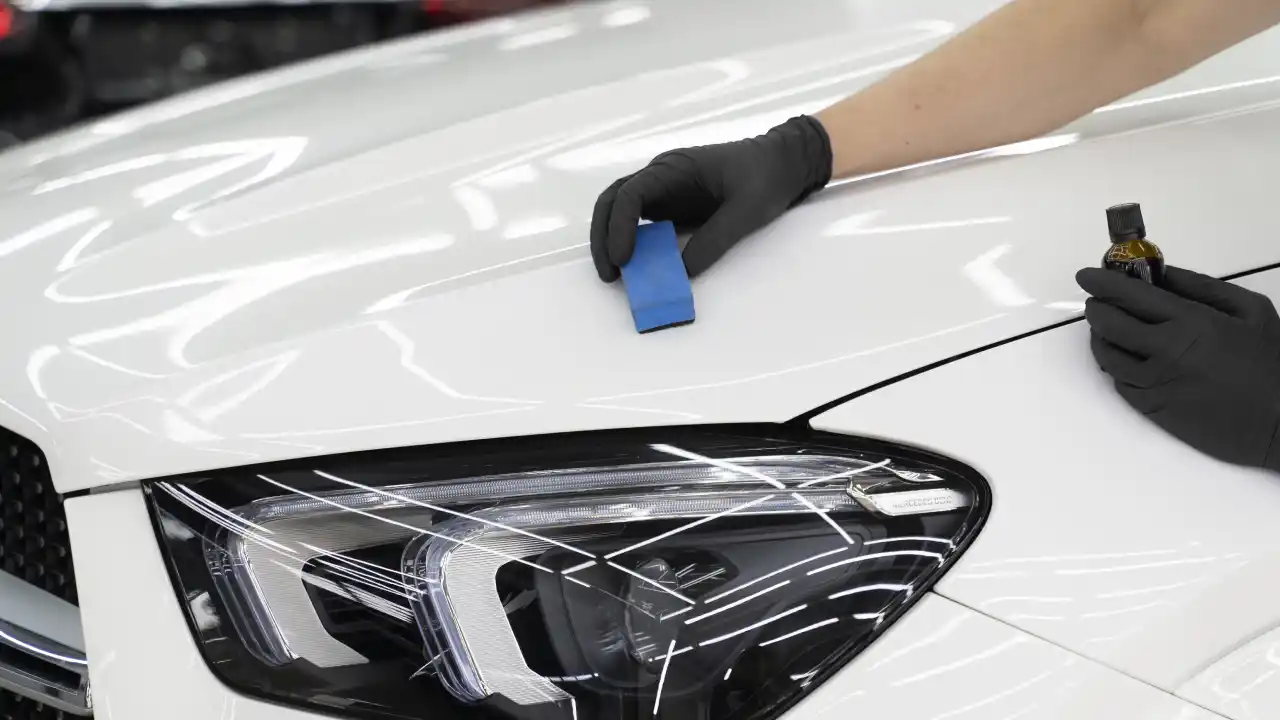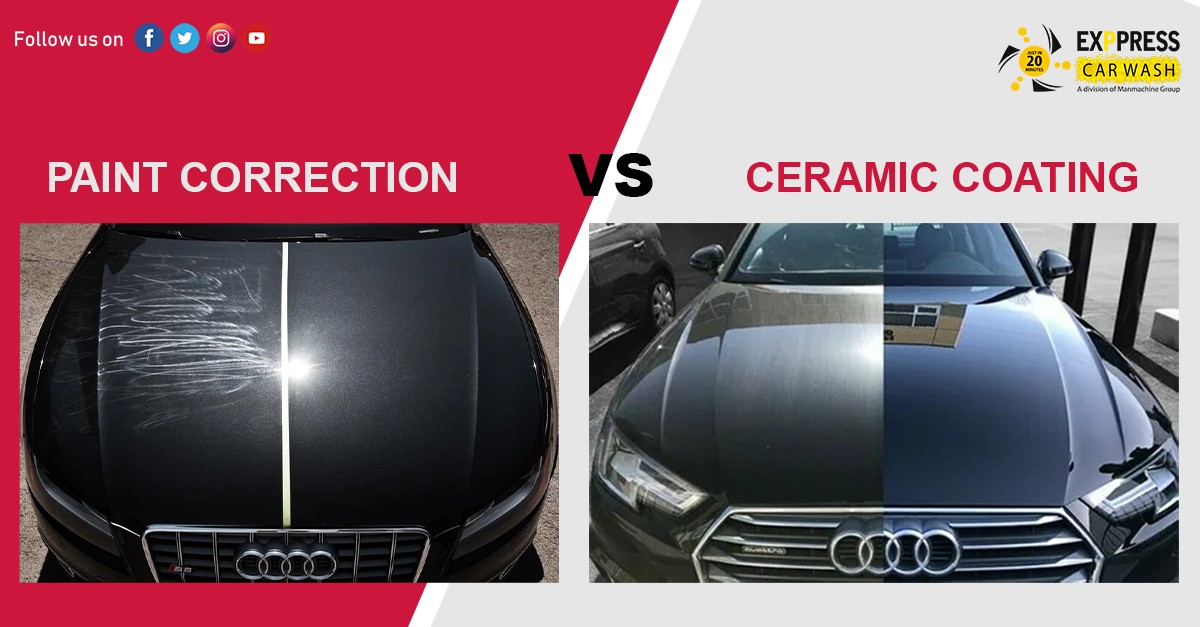Exploring the Science Behind Ceramic Coating and Its Effect On Auto Outlining
The application of ceramic covering in vehicle detailing stands for a considerable improvement in vehicle care, rooted in its sophisticated chemical homes, mainly silica dioxide and titanium dioxide. As we explore the details of the application procedure and the long-lasting implications for lorry maintenance, it becomes clear that the choice of ceramic layer can essentially alter one's approach to auto treatment.
What Is Ceramic Finishing?
Ceramic finishing is a modern remedy that has obtained popularity in the auto detailing sector for its ability to supply lasting defense for lorry surfaces. This innovative protective layer is commonly composed of silica dioxide (SiO2), which develops a solid bond with the car's paint, developing a durable shield versus environmental impurities. Unlike standard wax or sealers, ceramic coatings supply exceptional resistance to UV rays, chemical stains, and physical abrasions.
The application of ceramic coating entails a meticulous process, where the lorry's surface is extensively cleansed and decontaminated prior to the layer is applied (Ceramic Coating). When treated, the layer boosts the lorry's gloss, deepness, and clearness, supplying a showroom-quality coating that lasts for years. One of the essential benefits of ceramic finish is its hydrophobic buildings, which repel water and dust, making upkeep easier and reducing the frequency of washes
The Chemistry of Ceramic Finishing
A fundamental aspect of ceramic coating exists in its chemical structure, mostly defined by the presence of silica dioxide (SiO2) This compound is indispensable to the development of a sturdy, safety layer that bonds chemically to the car's surface.
In addition to SiO2, many ceramic finishings integrate titanium dioxide (TiO2) and various other ingredients to enhance their efficiency attributes. TiO2, as an example, contributes to raised firmness and chemical resistance. The interaction in between these compounds creates an unique molecular framework that provides a high degree of security against ecological elements such as UV rays, acid rainfall, and oxidation.
Moreover, the application process usually includes a precise prep work of the surface to make certain ideal attachment of the finishing. This chemistry not only makes sure a long-lasting coating but additionally enhances the visual charm of the vehicle. Comprehending the intricate chemistry behind ceramic layers is vital for detailing experts that aim to give exceptional protection and long life for their clients' automobiles.
Advantages of Ceramic Finishing
While detailing professionals commonly highlight the advantages of ceramic finishings, their advantages extend far past visual appeals. The main advantage is superior security versus ecological impurities. Ceramic coverings produce a hydrophobic surface area that repels grime, dirt, and water, substantially reducing the frequency of laundries and the effort needed to preserve a lorry's look. This safety layer additionally guards the paint from hazardous ultraviolet rays, stopping oxidation and fading with time.
In addition, ceramic finishes improve the durability of the car's finish. Unlike typical waxes or sealers, which may last a few months, ceramic coatings can sustain for many years, offering a long-term solution for auto treatment. This longevity equates to cost financial savings, as proprietors are less most likely to need frequent reapplication.
In addition, ceramic finishes are resistant to chemical stains and etching, which can take place from acidic compounds like bird droppings or tree sap. This resistance not only maintains the automobile's aesthetics yet also decreases prospective damage - Ceramic Coating. On the whole, the investment in ceramic coating supplies cars and truck owners a significant return in regards to protection, convenience of maintenance, and durable visual allure, making it a progressively popular selection in the world of automobile describing
Application Process Clarified

As soon as the surface is effectively prepared, the ceramic finish can be applied. It is usually performed in a controlled setting, such as a garage or describing bay, to stop contamination from dust and debris. Making use of an applicator pad, the service technician applies the covering in tiny areas, operating in a see post crosshatch pattern to ensure also protection. It is important to comply with the manufacturer's instructions regarding application density and treating times.
Once healed, the ceramic coating develops a solid bond with the paint, providing improved defense and a glossy surface. Correct application is important to make best use of the durability and performance of the ceramic finish.

Long-term Influence On Vehicle Treatment
The lasting influence of ceramic finish on automobile treatment is considerable, as it fundamentally alters exactly how owners keep their automobiles. By producing a resilient, hydrophobic layer on the vehicle's surface area, ceramic coverings minimize the adherence of dust, gunk, and contaminants. This residential or commercial property reduces the frequency of cleaning needed, ultimately preserving water and cleaning products.
In Addition, the UV protection used by ceramic finishings helps to stop oxidation and fading of the car's paint, preserving its aesthetic appeal and look at here now resale worth gradually - Ceramic Coating. This safety barrier also minimizes the likelihood of scratches and swirl marks, which are usual problems in typical paint finishes
Moreover, ceramic finishings promote less complicated maintenance, permitting owners to clean their lorries with minimal initiative. The smooth surface area makes it challenging for impurities to bond, enabling easier removal during regular cleaning.
In the future, the investment in ceramic finish may cause cost financial savings in lorry care product or services. Overall, the withstanding advantages of ceramic coverings not just boost the appearance of cars however also add to a much more reliable and sustainable approach to car maintenance.
Verdict
In verdict, the application of ceramic covering represents a substantial advancement in vehicle detailing, driven by its special chemical structure of silica dioxide and titanium dioxide. This innovation not only improves the aesthetic charm of lorries yet additionally gives durable security against environmental risks and use. The long-term benefits, including reduced upkeep regularity and boosted resilience, underscore the value of ceramic coverings as a crucial financial investment for keeping automobile appearance and integrity with time.
